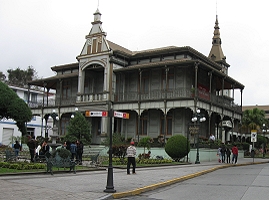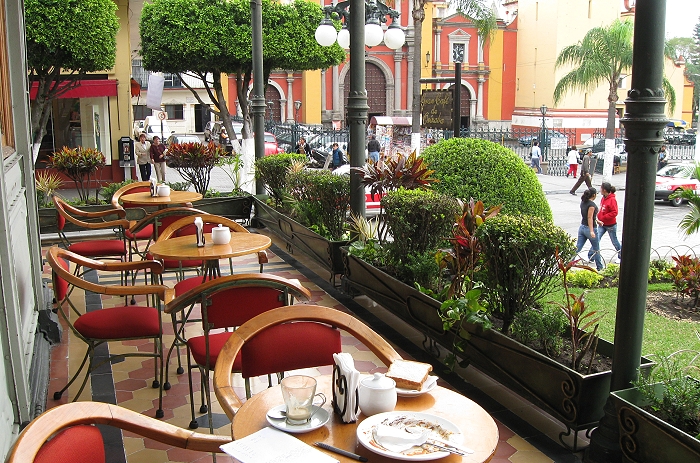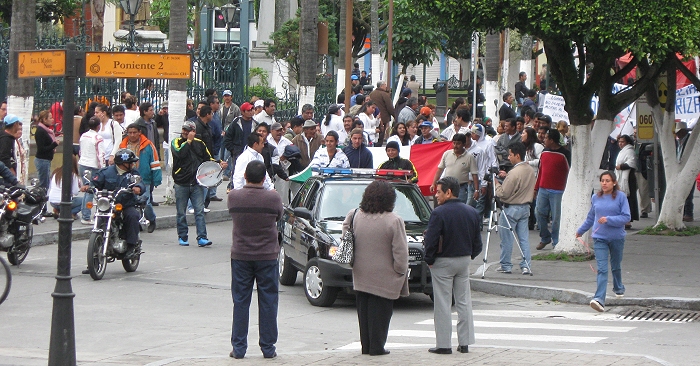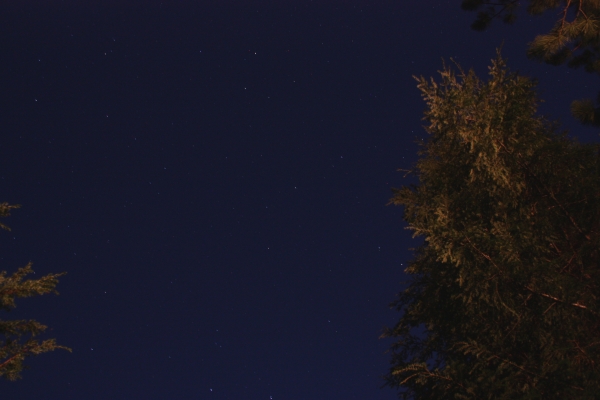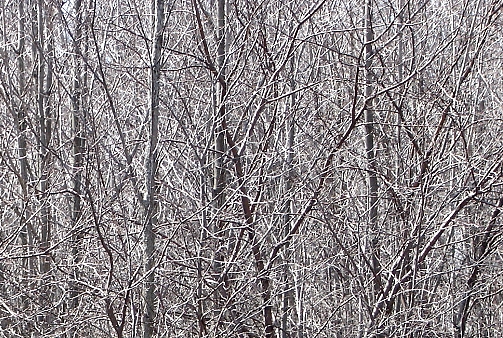| Currently Gallery Original Prints Books Bio Contact Home |
 |
 Orizaba |
|||||||||
The waiter, when he wandered up to take my order, tells me the peak can usually be seen from the corner of the patio, “Cuando no hay nubes” (when there are no clouds). Then he adds, cheerfully, "But you should be able to see it "el Sabado."" Sadly, I'll be back in Mexico City on Saturday. "Perfect," I whispered to myself, as a couple of regulars catch his attention for a moment. After coming all this way, Orizaba decides to reveal herself on a day I'm going to be somewhere else – on Saturn's day, no less. The sun made intermittent appearances though, almost breaking through the thinning layers of cloud – a flat, pale, whitish disc. I couldn't possibly feel too disappointed, Orizaba might show herself even yet, and if she didn't, here I was, on the very slopes of that iconic Volcano. The colour, music and frenzied activity, that is Mexico, always has a way of cheering me up.
I savored my steaming hot cafe con leche, as a the occasional mist of water droplets drifted through the patio railings. In the north of England or Scotland, I'd have expected this sort of weather, although here it felt rather strange – But this wasn't your average Mexican town. My plate of Huevos Rancheros arrived and, at that very moment, the calm was shattered as a boisterous procession emerged from a side street across from the Palacio's gardens. Complete with police escort, drummers and loud speakers blaring unintelligible speeches, the chanting throng turned the corner and passed along front of the building. As far as I could tell, from the numerous banners and placards, it was a protest by local trade unions over new taxes, to be levied, if I understood correctly, as the town of Orizaba was to amalgamated into a larger political district. One of the smaller signs caught my eye, it read (In Spanish): Comrades. We should not leave the dying to the Zapatistas. Lets fight! This suddenly brought back memories of an earlier trip to the south – Chiapas in 1993 – and for a moment I felt a slight rush of anxiety.
Traveling back from Guatemala, I'd spent a few days in and around San Cristobal de las Casas, it was one of the highlights of the that particular tour around Central America, only a few months, as it happened, before the Zapatista uprising. One image especially lingers in my mind to this day, a picture posted online shortly after the fighting had subsided. A body lay next to a bench in one of the gardens, the same bench, in fact, on which I had sat studying a map that I'd picked in the nearby tourist information – The veil between our experiences of the world, and another, quite different, seems so very thin at times. I thought too of all the warnings I'd received from friends before I left home this time, much like my first journey to Mexico in 1988. Having watched numerous disturbing reports of gang violence along the border, they had painted all of Mexico with the same brush. It was sad I thought, speculating on how many visitors might also have planned to come here, but stayed home instead, or went off to some anonymous all inclusive resort in another country. In 1993, on my second trip to Mexico, neither the town of Orizaba, nor the volcano for which it is named, appeared in my travel guide. Even stranger – considering Pico de Orizaba is the third highest peak in North America and the area surrounding it the most beautiful in Mexico – the vast majority of guides books make no mention of this place, even today. (A recent, informal survey at the World's Biggest Bookstore, only one of the five books I checked, made any mention of the town). I felt an immediate empathy for these everyday people as they marched on by. “Todos Somos Orizaba” (We Are Orizaba) read a number of the banners, and I could understand their pride in this place. The rest of the day was wet and overcast, with a final down pour that began around dinner time and lasted much of the night. By morning, the system seemed to have exhausted itself, and the sun reappeared, earlier than the waiter had predicted. Thick low-lying cloud still clung about the mountains in the west however, and when it did clear, a dense lenticular cloud descended; draping itself squarely over Orizaba's summit – and much of her lower slopes too. It was a surreal sight, quite befitting the aura of mystery this mountain had acquired in my imagination; and I wondered if the 'layers of daylight' and 'sheet-lightening' that lay over the Navajo sacred mountains had looked anything like this.* From almost anywhere in town, the bulk of Pico de Orizaba was hidden behind steep, wooded hills, though a small portion of her snow covered slopes flashed seductively through the shifting layers of shining gossamer. The smooth, gentle arc of her flank was revealed. “Nice climb” I thought, which almost seemed irreverent at this point, but 18,500 feet would require slightly more preparation than a quick scramble to the top of Stob Coire. There was no chance of an impromptu ascent this time. After breakfast I wandered around town for a while and then headed back towards the bus station. Along the way a crystal clear river flowed down from the melting snow pack and crossed the west end of town. I stopped for a moment to watch it rushing underneath the bridge I stood on, and then backtracked to some mossy stairs that lead to a path along its bank. At the edge, I crouched on a low rock and dipped in my hand into the fresh, cool water. As the current rushed between my fingers it felt, for an instant, as though I had touched Orizaba's pristine, snow-covered slopes. Two hours later the bus was well on its way to Puebla. Emerging from the mountains the road descended steadily, heading almost directly towards Popocatepetl – that other “Big Volcano” – and Orizaba's veil began to disperse. I craned my neck, as the bus turned slowly away, and manged to snap a picture of what looked to be the peak itself; just the faintest glimpse through a small window in the cloud. Orizaba had stayed well hidden, but her Muses, which I now felt quite certain must reside somewhere up there, had worked their magic, and I knew I would return. I had said that before of course, about San Miguel. I felt a little more confident this time as, tomorrow morning, at long last, I would be making my way there. It had better not take twenty one years to get back to Orizaba though, if I seriously planned on scrambling to the summit that is. * The Navajo creation myth.
Return to main page |
||||||||||
 |
 Painting today |
|||||||||
There is a fine line between inspired recreation and mundane reproduction, even parody. This reenactment appears to have been an attempt to make art accessible to all, which is a laudable objective in and of itself, but the accessibility here is in the manner of Fluxus. Democratizing art was a key point in the Fluxus manifesto, not just the viewing of art, but also the production of art. This objective has huge implications and is the subject of my next piece. For the time being though, as the review suggests, the object of recreating reality is to create something more than a simple reproduction – and to do this, something more is required from the artist. In this case, that extra something was not apparent. I did not see the event in person, so I can only infer this, but, for anyone who has sat beside a real campfire, it is easy to see how such a piece would seem a pale facsimile. On another level, while 'performance' suffers a setback, realism reveals itself as an essential component of art, something that cannot be suppressed indefinitely.
Return to main page. |
||||||||||
Art in a Wal-Mart World When I made mention of TVO's upcoming Agenda program in my update of March 10th, I had no knowledge of the program's contents (beyond those implied in the title of course) and if you tuned in to watch that episode, it will have occurred to you that painting, as an art form itself, was not actually mentioned. Naturally, this begs the question: Why? http://www.tvo.org/cfmx/tvoorg/theagenda/index.cfm?page_id=741 The purpose of my own commentary though, given the conspicuous absence of the visual arts in this discussion, is to explain the reasons I believe it was omitted. The title of this piece, Art in a Wal-Mart World, goes only part of the way in explaining why painting was not one of panel's discussion items. The 'Wal-Martization' of art is more a symptom than a cause, however, and an inevitable consequence of a hundred years of artistic deconstruction. Thus, we need to look back. Before I elaborate, it must be said that I am completely enamored with Modernism. The art and the ideas, all of it, up until about 1940 that is, after which point it seems that everything there was to say had already been said. Modernism continued to evolve of course, as is its nature, though I cannot muster much enthusiasm for its later incarnations. Post-Modernism makes no excuses for its appropriation, recombining and repackaging of preexisting material, but I always smile when I think of a comment made by the renown designer Massimo Vignelli, when he speaks of the “disease called Post-Modernism.”* My own feelings are not quite so strong, but I do understand his vehemence. How minimalism and deconstruction lead to the marginalization of painting, and the Wal-Martization of art, is a long and convoluted journey. In a world where the traditional image has been stripped of all its original values, completely deconstructed and then cast aside in favor of found objects, installations, and, eventually, performance art, what is left? The answer: Decorator art. Popular culture has reduced flat art to not much more than expensive wallcovering. If the art has nothing to say, if the artist has nothing to say, then art is just a commodity like any other. If this is the case, Chinese factories can manufacture 'product' much more efficiently than any artist...and will. This realization came to me last year when I was camping with my family in Killarney. I had bought a copy of the Toronto Star en route, first to read, and then to start campfires. In one section, New In Homes & Condos was a piece by the popular designers Colin and Justin. They were doing there usual thing of course, advising on trendy home décor options, and, under the heading “ARTWORK,” they suggested that box stores, including Ikea and Home Depot, even your local supermarket, can provide the perfect finishing touches for any room. It is very true that you don't need to spend a lot of money on art. I haven't participated in the big art festival shows for a long time now, but I thought it was an important commentary on the times that even art is now being outsourced. Local artists, at the TOAE, Artists Project, and other such group exhibitions, are feeling the pinch as a result. This was a watershed moment. After fifty years of indoctrination by an art establishment that has been systematically dismantling art, it is time for individual artists to again find their voices, and make a case for the relevance of their work in the modern world. The only reference to painting that might be inferred from the Agenda program was in a video clip of the American 'artist,' Hennessy Youngman, who proposed, at some length, the idea that "talent" was no longer essential when creating art. View video: http://www.youtube.com/user/HennesyYoungman#p/u/5/vVFasyCvEOg I thought this was an interesting aside – though a piece of 'performance art' itself – as I made a passing mention in my previous update to the Fluxus movement. The essential principle of which (and I hate to take the wind out of Hennessy's sails) is that 'practiced' art – anything premeditated or done with intention, training and skill – is not real art. It is craft. See The Fluxus manifesto: http://www.artnotart.com/fluxus/gmaciunas-manifesto.html When I visited the Tate Modern in 2008, I was 'fortunate' to actually witness a Fluxus "happening." Alongside a performance of atonal “noise” music (presented with great earnestness by a small otherwise classical ensemble) was an interactive demonstration in which visitors were encouraged to participate. The 'piece' consisted of ping-pong tables where visitors could improvise games using a wide assortment of fresh fruit and vegetables, instead of paddles. The interactions that occur spontaneously and the unintentional consequences of this process – to a Fluxus adherent at least - represents pure art. The idea of questioning the definition of art itself is something that began with Marcel Duchamp in 1917 when he displayed the piece entitled Fountain, a urinal with a few letters scrawled on it. Sadly, this questioning seems to have become a preoccupation, and art has continued to gaze inward at itself, though Fluxus was only a short-lived phenomenon. Duchamp, after a long and controversial career, was one of the key members of the original Fluxus experiment, but quickly moved on to other things. The concept that someone completely untrained and “unskilled,” in what ever the medium at hand happens to be, can create pure art, is essential self defeating, and it is no wonder this movement is not among the more well-known in art history. Immediately on the heels Abstract Expressionism, Fluxus 'painted' conventional art into a corner (ideologically speaking). But, from this conceptual experiment, three key ideas moved into the fore: the accidental, art as an interactive process, and art as performance. We have been living with the consequences ever since. For many years, painting has been considered an 'out-moded' form of expression (see my 2006 update: http://www.wdavidward.com/currently9.htm#item4). Since the 60s, installation art has been all the rage, and it is still very popular, more recently though, performance art has become the most lauded form of expression. I wrote about this in an earlier update when the Turner prize in London was awarded to a performance piece, which consisted of a man in a bear suit wandering around an empty art gallery in Berlin (which is an ironic commentary in itself). To further illustrate this point, MoMA recently hosted a very interesting art performance (March 2010) where an artist sat for hours at a time staring blankly across an empty table. Visitors were invited to sit across for her, and stare back. Little happened of course, and what did happen was largely a result of those who chose to participate. (Art has to be interactive now, don't forget.) The occasional giggle or a teary eye seems to have been the extent of it, but you can watch for yourself: View video: I say this piece was interesting because it illustrates a fascinating continuation of the deconstructivist bent of contemporary art. That penchant for minimalism has now even managed to strip the performance out of “performance” art. On the MoMA website, ninety-three years after Duchamp's urinal, the question 'Is this art?' is still being asked. Perhaps it is time to concede that we might never know what art is, really. We do know however, and instictively, when something speaks to us. So maybe the question we should be asking now is: What does it actually have to say? * Helvetica, 2007. Documentary Film by director Gary Hustwit. |
||||||||||
Is This Art?
This version of the essay above appeared in Surfacing Magazine in September 2011, with the title: |
© W. David Ward All rights reserved |


